The Twisted Brazilian Version of Halloween
It’s Not a Traditional Brazilian Holiday

While you Santa Barbarans water-ballooned out-of-towners from your Del Playa balconies or handed out candy from your hillside dwellings, I stumbled down the beach among a thousand dead people.
Halloween came to Brazil just as it would. Late. Confused. On the beach. Costumed. With caiparinhas [the traditional Brazilian cocktails]. To the tune of funk. In the form of a parade.
Halloween is not a Brazilian holiday. But for a Catholic, non-celebrating country, the week surrounding the October/November transition was frighteningly festive. Where the Carioca lacks familiarity with trick-or-treating or bobbing for apples, he or she is skilled in the art of guising. Just as the Irish and Scotts began to do some 200 years ago, people came up with costumes.
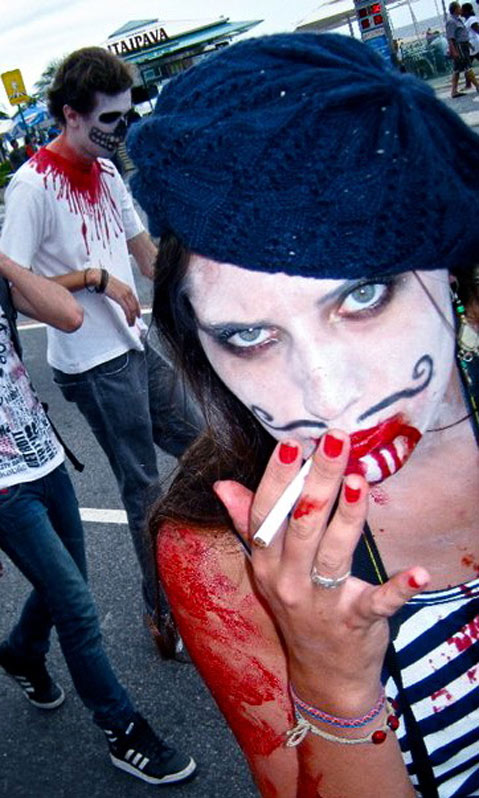
It is entirely possible to pass Halloween in Rio without having anything to do with it. I estimate that more than half of my Brazilian peers and a significantly greater percentage of people from older generations did just this: nothing.
But those who did choose to celebrate the holiday did so with great enthusiasm, if not with traditional accuracy. My experiences with Halloween in Rio came in three forms.
1: History Continues
Brazil is absurdly affected by popular culture from the United States. The language to learn here is English; it is taught obligatorily in schools from an early age. Rio is also the turf of numerous institutions that specialize specifically in English. It is these schools that are credited with having first brought Halloween to Brazil. (Of course, the decoration, candy, and costume industries took it from there.)

This is where I come in. The Instituto Dois Irmãos (or Two Brothers Institute), where my fellow Gringo volunteers and I teach English in Rocinha, annually holds a Halloween party. In the past, the party aimed primarily to introduce to English students the holiday that is so culturally strong in the English-speaking world. This year, for the first time, it was a fundraising party. We charged for entrance and drinks, occupied a bigger space, and saw a bigger turnout than in previous years. Money raised will go toward classroom supplies next semester.
An evening party for the kid students was followed by a late night party for adults. Kids came in classic Halloween costumes. About ten little witches, a few Screams, a few princesses, and a couple of wizards made up the bulk of the crowd of children. One eight-year-old managed to get his hands on an Obama mask; he got a lot of attention from the American volunteers.
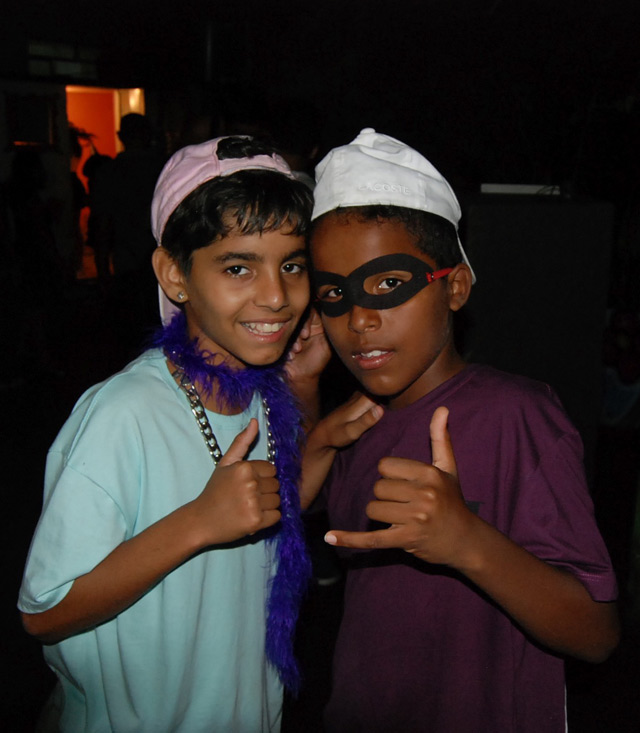
The adult party was a whole different scene. It ended up being one of those inevitable parties that I like to refer to as a “Gringo Fest.” Foreigners living in Rio form communication networks, and the institute’s volunteers made sure every gringo in Rio knew about the party. I’m talking about exchange students all over the city, backpackers in hostels, and people working abroad. Curious about favelas – communities of Rio into which the overwhelming majority of foreigners never venture – and looking to get their Halloween fix, they filled the venue.
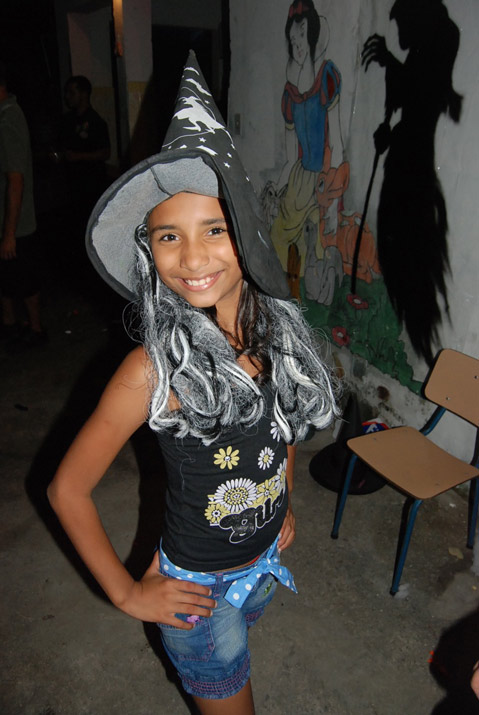
I was working the door, so I got to take notes. There I sat with my ex-student and good friend Dentão (Portuguese for “Big Teeth”) from midnight to 4 a.m., collecting money from and putting bracelets on costumed gringos from Colombia to France, Mexico to Portugal, Canada to Japan, the US to Australia. There was a notable absence of Brazilians – they made up perhaps 20 percent and were almost all students of the Institute. But the ever-changing crowd of awe-struck community members on the street outside the party made up for this. Men sat on stoops and stared as gringo after gringo rolled up on moto-taxies in ridiculous attire. “What are all these French superheroes doing in Rocinha?” “Since when do Asian countries produce pirates?” “I’ve never seen so many sexy white girls in heels and vampire garb in my life!”
The exchange was perfect: While partygoers enjoyed the party in Rocinha with caiparinhas and funk carioca music, local observers got the chance to learn all about Halloween’s absurdities.

2: Lapa
There remains a lot to be said about the Halloween not brought to Rio by us foreigners, but produced right here by its own inhabitants. Lapa is this city’s party capital. Its interesting history has it developing over recent decades from a sketchy, crime-ridden area known for cachaça, drugs, rapists, robbers and prostitutes into a relatively classy area. It certainly still has all of those things, but fewer of them, and fancy, expensive bars and clubs are on the rise. The few blocks of madness punctuated by famous, picturesque, towering white arches are a must-visit , especially on Friday nights, for visitors to Rio.

It only makes sense that Lapa’s businesses would take into account the absurd number of foreigners in Rio and strategically implement foreign cultures into their themed nights. The Friday night before Halloween weekend, party promoters handing out flyers to various Halloween parties occupied every corner. I must have reluctantly collected invitations to 15 different Halloween parties to be held in the small area through the following week.
Even so, almost all Cariocas with whom I talked were still curious. They’ve all heard of Halloween. But they’re not so sure of its reasons, its execution.
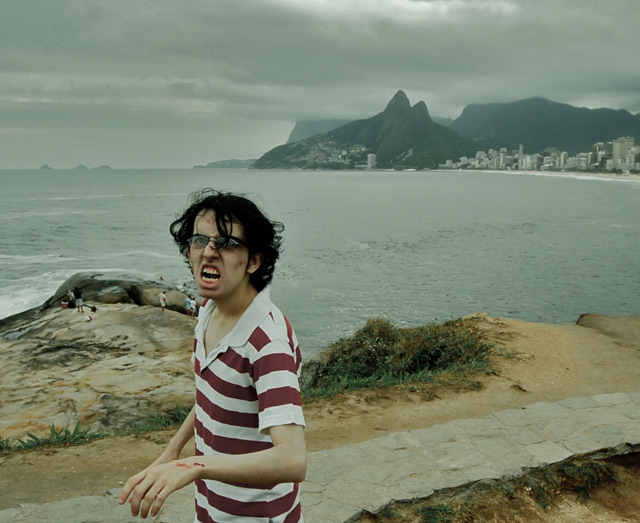
3. Zombies Invade Copacabana Beach
November 2 is the Dia dos Mortos – the Day of the Dead – in Christian tradition. With delightful irony, hundreds of zombies came out to parade down the most crowded, famous beach in Rio de Janeiro. It was Rio’s fourth annual Zombie Walk – an event organized through Orkut (Brazil’s version of MySpace) in various Brazilian cities.

The concept is simple, the results awesomely disgusting. Participants gather on the sidewalk by the beach in the afternoon. Individuals and groups then proceed to get into character. The zombies are themed. White and then black make up piles onto faces and bodies. The blood was sweet and sticky. Bottles of it made their way around the crowd. It was splattered on everybody, sticking everything to everything and running from every mouth. Among end results were zombie versions of doctors, nurses, ogres, characters from video games, waiters, mothers, Jesuses, transvestites, an Edward Scissorhands, a Quail Man, a Ronald McDonald, a Michael Jackson, and many more. As for me, I was a French zombie photographer, a good excuse for my foreign accent.
The end of the walk landed us all at the area between Copacabana and Ipanema Beaches on big scenic rocks that serve as the backdrop for many tourists’ photos daily. They scattered as our bloody, deranged crew invaded. After, everybody jumped into the sea to die again and be reborn clean.
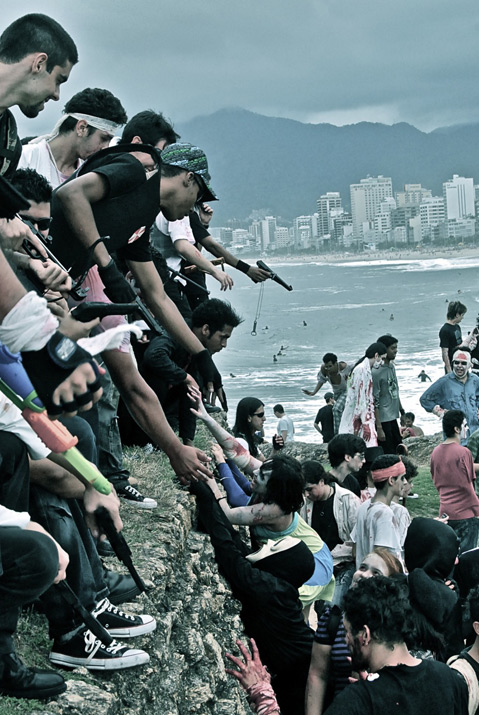
Members of the Zombie Walk do not claim to affiliate with Halloween, but they clearly do. The annual walk always falls near Halloween, and Zombies are scary.
Weather you’re a gringo, kid, Funqueiro (Funk Carioca music fanatic), fan of zombie films, or simply a curious Brazilian, there’s a Halloween for you in Rio de Janeiro. It may be slightly eccentric in its execution, but, far away from the Halloween capital of the northern hemisphere, I certainly encountered enough costuming occasions to get my fix.



